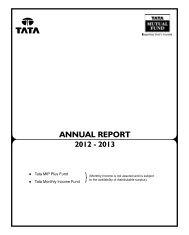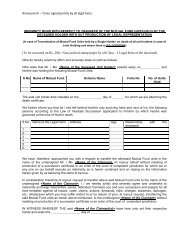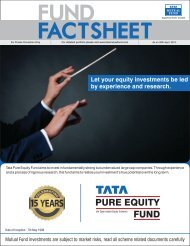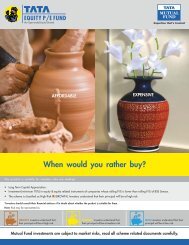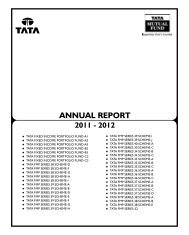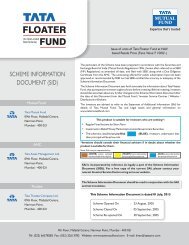Tata Fixed Tenure Fund Series - 2 Scheme B - Securities and ...
Tata Fixed Tenure Fund Series - 2 Scheme B - Securities and ...
Tata Fixed Tenure Fund Series - 2 Scheme B - Securities and ...
You also want an ePaper? Increase the reach of your titles
YUMPU automatically turns print PDFs into web optimized ePapers that Google loves.
TATA FIXED TENURE FUND SERIES 2<br />
industries, sectors, etc. by the <strong>Scheme</strong> is avoided, the funds invested by the <strong>Scheme</strong> in certain securities of industries, sectors, etc. may acquire a<br />
substantial portion of the <strong>Scheme</strong>’s investment portfolio <strong>and</strong> collectively may constitute a risk associated with non-diversification <strong>and</strong> thus could<br />
affect the value of investments. Reduced liquidity in the secondary market may have an adverse impact on market price <strong>and</strong> the <strong>Scheme</strong>’s ability to<br />
dispose of particular securities, when necessary, to meet the <strong>Scheme</strong>’s liquidity needs or in response to a specific economic event or during<br />
restructuring of the <strong>Scheme</strong>’s investment portfolio.<br />
Investment Risks<br />
The value of, <strong>and</strong> income from, an investment in the <strong>Scheme</strong> can decrease as well as increase, depending on a variety of factors which may affect<br />
the values <strong>and</strong> income generated by the <strong>Scheme</strong>’s portfolio of securities. The returns of the <strong>Scheme</strong>’s investments are based on the current yields<br />
of the securities, which may be affected generally by factors affecting capital markets such as price <strong>and</strong> volume, volatility in the stock markets,<br />
interest rates, currency exchange rates, foreign investment, changes in Government <strong>and</strong> Reserve Bank of India policy, taxation, political, economic<br />
or other developments, closure of the Stock Exchanges etc. Investors should underst<strong>and</strong> that the investment pattern indicated, in line with prevailing<br />
market conditions, is only a hypothetical example as all investments involve risk <strong>and</strong> there is no assurance that the <strong>Scheme</strong>’s investment objective<br />
will be attained or that the <strong>Scheme</strong> be in a position to maintain the model percentage of investment pattern particularly under exceptional<br />
circumstances.<br />
Different types of securities in which the scheme would invest in the SID carry different levels <strong>and</strong> types of risk. Accordingly the scheme’s risk may<br />
increase or decrease depending upon its investment pattern. e.g corporate bonds carry a higher amount of risk than Government securities. Further<br />
even among corporate bonds, bonds which are AAA rated are comparatively less risky than bonds which are AA rated.<br />
The scheme may use techniques <strong>and</strong> instruments (as disclosed in the clause “portfolio turnover”) for efficient portfolio management <strong>and</strong> to attempt<br />
to hedge or reduce the risk of such fluctuations. However these techniques <strong>and</strong> instruments if imperfectly used have the risk of the scheme incurring<br />
losses due to mismatches particularly in a volatile market. The <strong>Fund</strong>’s ability to use these techniques may be limited by market conditions,<br />
regulatory limits <strong>and</strong> tax considerations (if any). The use of these techniques is dependent on the ability to predict movements in the prices of<br />
securities being hedged <strong>and</strong> movements in interest rates. There exists an imperfect correlation between the hedging instruments <strong>and</strong> the securities<br />
or market sectors being hedged. Besides, the fact that skills needed to use these instruments are different from those needed to select the <strong>Fund</strong>’s /<br />
<strong>Scheme</strong>’s securities. There is a possible absence of a liquid market for any particular instrument at any particular time even though the futures <strong>and</strong><br />
options may be bought <strong>and</strong> sold on an organised exchange. The use of these techniques involves possible impediments to effective portfolio<br />
management or the ability to meet repurchase / redemption requests or other short-term obligations because of the percentage of the <strong>Scheme</strong>’s<br />
assets segregated to cover its obligations.<br />
Risks Associated with Securitised Debt<br />
Risk due to prepayment: In case of securitized debt, changes in market interest rates <strong>and</strong> pre-payments may not change the absolute amount of<br />
receivables for the investors but may have an impact on the reinvestment of the periodic cash flows that an investor receives on securitized papers.<br />
In the event of pre-payment of the underlying debt, investors may be exposed to changes in tenor <strong>and</strong> yield.<br />
Liquidity Risk: Presently, despite recent legal developments permitting the listing of securitized debt instruments, the secondary market for<br />
securitized debt in India is not very liquid. Even if a more liquid market develops in the future, secondary transactions in such instruments may be at<br />
a discount to initial issue price due to changes in the interest rate structure.<br />
Limited Recourse <strong>and</strong> Credit Risk: Certificates issued on investment in securitized debt represent a beneficial interest in the underlying<br />
receivables <strong>and</strong> there is no obligation on the issuer, seller or the originator in that regard. Defaults on the underlying loan can adversely affect the<br />
pay outs to the investors <strong>and</strong> thereby, adversely affect the NAV of the <strong>Scheme</strong>. While it is possible to repossess <strong>and</strong> sell the underlying asset,<br />
various factors can delay or prevent repossession <strong>and</strong> the price obtained on sale of such assets may be low.<br />
Bankruptcy Risk: If the originator of securitized debt instruments in which the <strong>Scheme</strong> invests is subject to bankruptcy proceedings <strong>and</strong> the court<br />
in such proceedings concludes that the sale of the assets from originator to the trust was not a 'true sale', then the <strong>Scheme</strong> could experience losses<br />
or delays in the payments due. Normally, care is taken in structuring the securitization transaction so as to minimize the risk of the sale to the trust<br />
not being construed as a 'true sale'.<br />
Risk of Co-mingling: Servicers in a securitization transaction normally deposit all payments received from the obligors into a collection account.<br />
However, there could be a time gap between collection by a servicer <strong>and</strong> depositing the same into the collection account. In this interim period,<br />
collections from the loan agreements by the servicer may not be segregated from other funds of the servicer. If the Servicer fails to remit such funds<br />
due to investors, investors in the <strong>Scheme</strong> may be exposed to a potential loss.<br />
<strong>Securities</strong> Lending Risks<br />
It may be noted that this activity would have the inherent probability of collateral value drastically falling in times of strong downward market trends,<br />
rendering the value of collateral inadequate until such time as that diminution in value is replenished by additional security. It is also possible that<br />
the borrowing party <strong>and</strong>/or the approved intermediary may suddenly suffer severe business setback <strong>and</strong> become unable to honour its commitments.<br />
This, along with a simultaneous fall in value of collateral would render potential loss to the <strong>Scheme</strong>. Besides, there is also be temporary illiquidity of<br />
the securities that are lent out <strong>and</strong> the scheme will not be able to sell such lent out securities until they are returned.<br />
Interest Rate Risk<br />
As with debt instruments, changes in interest rate may affect the <strong>Scheme</strong>’s net asset value. Generally the prices of instruments increase as interest<br />
rates decline <strong>and</strong> decrease as interest rates rise. Prices of long-term securities fluctuate more in response to such interest rate changes than shortterm<br />
securities. Indian debt <strong>and</strong> government securities markets can be volatile leading to the possibility of price movements up or down in fixed<br />
income securities <strong>and</strong> thereby to possible movements in the NAV.<br />
Credit Risk<br />
Credit risk or Default risk refers to the risk that an issuer of a fixed income security may default (i.e. the issuer will be unable to make timely principal<br />
<strong>and</strong> interest payments on the security). Because of this risk corporate debentures are sold at a higher yield above those offered on Government<br />
<strong>Securities</strong> which are sovereign obligations <strong>and</strong> free of credit risk. Normally, the value of fixed income securities will fluctuate depending upon the<br />
changes in the perceived level of credit risk as well as any actual event of default. The greater the credit risk, the greater the yield required for<br />
someone to be compensated for the increased risk.<br />
Reinvestment Risk<br />
This risk refers to the difference in the interest rate levels at which cash flows received from the securities in the schemes are reinvested. The<br />
additional income from reinvestment is the “interest on interest” component. The risk is that the rate at which interim cash flows are reinvested may<br />
be lower than that originally assumed.<br />
Risks associated with Derivatives<br />
• Derivative products are leverage instruments <strong>and</strong> can provide disproportionate gains as well as disproportionate losses to the investors.<br />
Execution of such strategies depends upon the ability of the <strong>Fund</strong> Manager to identify such opportunities. Identification <strong>and</strong> execution of the<br />
3




